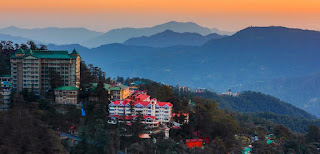The British changed the name of the hamlet Shymala to ''Simla'' because the name was a tongue-twister. Initially, in the early 1800s Shimla was just a nondescript village on a hill and was part of undivided Punjab. Having discovered the congenial climate prevailing there and its suitability to them, the British evinced keen interest to move uphill and build houses there. Though Deputy Commissioner’s office was set up in 1815 it was in 1819 CE the then Assistant Political Agent of hill states Lt. Ross set up the first British residence on the hill. It was a mere wooden cottage and it appeared to be just a jerrybuilt residence and not a permanent one.. Unfortunately, it was destroyed due to fire accident. A solid residence came up here and Ross' successor Lt. Charles Patt Kennedy built it as he had to stay there long with basic comforts. What was called the Kennedy House' built in 1822 was the first permanent house in Shimla. As the popularity of the hill station attracted the attention of senior officers of the English company who ran the colonial administration for the ''Crown'', they wanted a break, a sort of long respite from the horrible summer heat and scorching sun in the plains. Built on a crescent-shaped range of seven hills, Shimla was then rightly crowned as the 'Queen of Hills'
The British through a series of transactions with the Raja of Keonthal annexed Shimla hills. Like nearby Kasauli hill station (13 km from the station) Shimla, had sanatorium, particularly for the army men. The comfortable cold weather and the surrounding wooded areas helped them recover from severe illnesses. In 1864, Shimla was officially declared the summer capital of British India and the hill station got the attention of more Europeans after the mountain railway had been laid in 1903 connecting between Kalka and Shimla and the track going through wooded areas of deodar, pine, asphodel, hyacinth, celandine, fir, Himalayan oak, carmine & rhododendron trees. At an an altitude of 2075 metres (6820 ft) Shimla station is in a picturesque place. It was a remarkable engineering achievement done under the supervision of the then Chief Engineer and agent of the KSR H S Harington. Considered as one of the largest colonies in the world for almost 84 years, for the British Shimla was a home away from home, reminiscent of English weather and English rural ambiance.
 |
| first House 1822.-The Kennedy House, Shimla Flicker.com |
.jpg) |
| .The first House 1822.-The Kennedy House, Shimla, HPbl.uk |
Above image: Kennedy House Shimla, Himachal Pradesh. Photo by James Craddock taken in the 1870s, part of the Dunlop Smith Collection: Sir Charles Aitchison Album of Views in India and Burma. Snow scene, looking towards the house. The first house on the hill resort of Shimla (now serving as officers' mess), now the capital of the state of Himachal Pradesh. The nameplate on the gate announces it as the residence of 'Mr A. O'Meara, Surgeon Dentist'. O'Meara, who had come to Simla in 1850, was for many years the only dentist in the Punjab. Dr Barry O'Meara, the dentist's uncle, was Napoleon's doctor at St. Helena, on whose grave he planted a weeping willow, cuttings from which were sent to Simla.
 |
| Shimla, capital of HP. .travelxp.com |
https://www.bl.uk/onlinegallery/onlineex/apac/photocoll/k/019pho0000355s1u00017000.html




_at_Nagamangala.jfif)

.jfif)


.jfif)